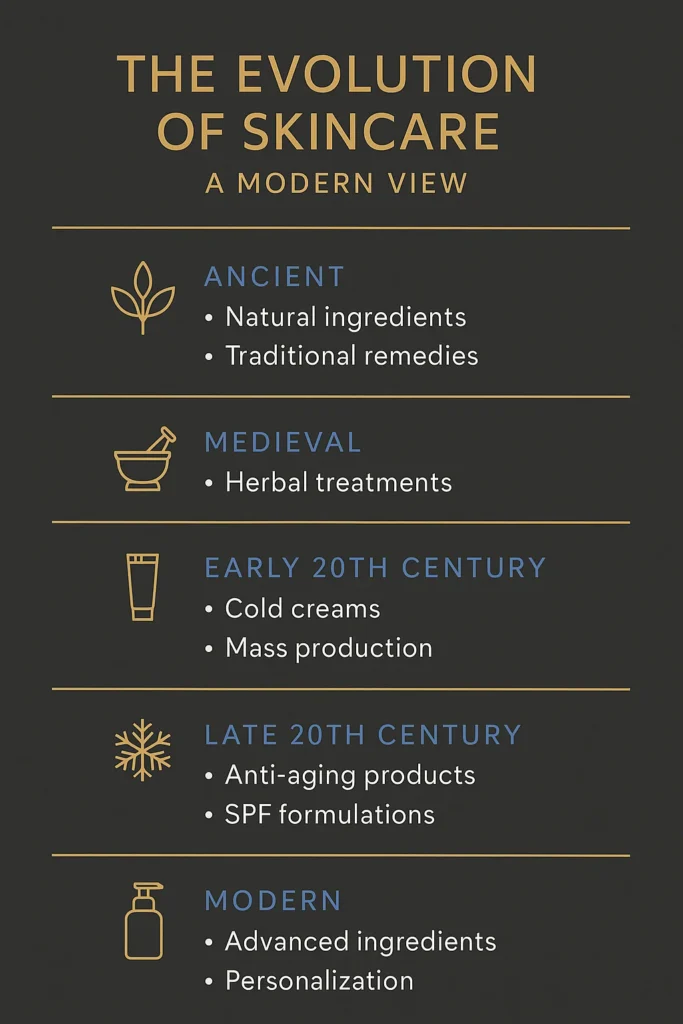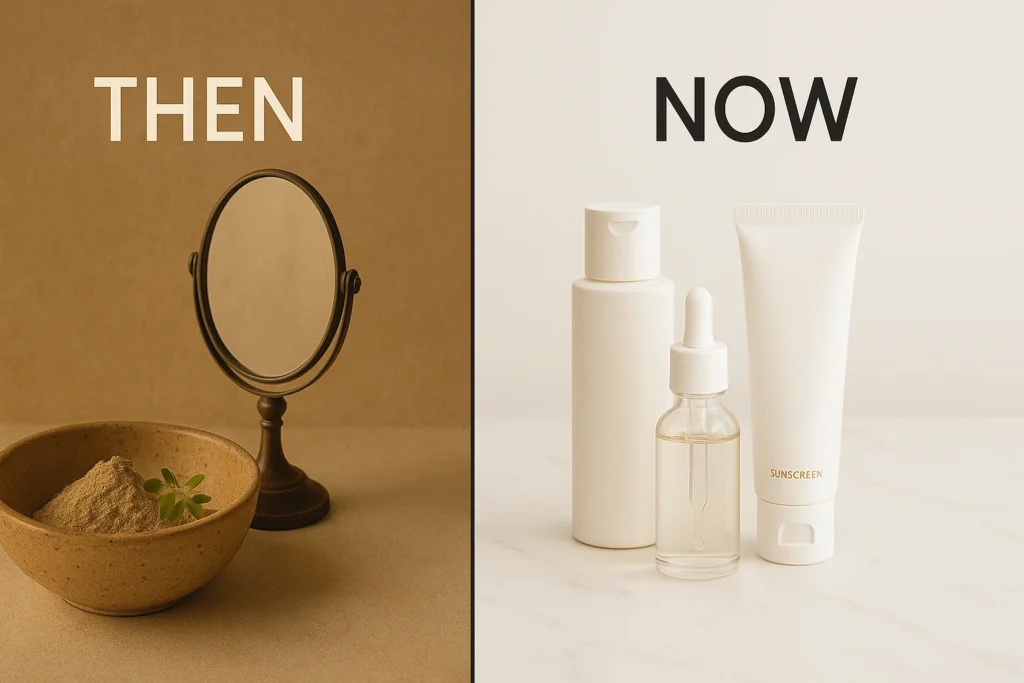The history of skincare shows how people have cared for their skin for thousands of years, from ancient natural remedies to today’s advanced products.
In a Nutshell: History of Skincare Timeline
- You will learn about skincare from ancient times to now.
- You will see how science and culture changed skin care.
- You will understand why today’s products are made the way they are.
Estimated reading time: 7 minutes
Ever wonder how people cared for their skin long ago? Skincare has a rich past. It shows how beauty and health ideas changed over time. Let’s explore this journey together.
Ancient Roots of Skincare
Early humans likely used natural items. They used animal fats, plant oils, and clays. These helped protect and moisturize skin.

- Ancient Egypt (~3000 BCE – 30 BCE): Egyptians were skincare pioneers. They valued beauty and clean habits. They used crushed minerals, essential oils, and milk for cleaning. Kohl, a dark eye makeup, also protected eyes and skin.
- Mesopotamia and Ancient China: Both cultures used natural herbs and oils. These were part of daily grooming. They also used them for skin treatments.
- Greek and Roman Influence: Greeks focused on physical health. This included skin care through bathing and natural remedies. Romans made bath culture bigger. They used scrubs, lotions, and spa treatments. These were for hygiene and social life.
These early ways used what nature gave them. They set basic ideas for clean skin, protection, and looking good.
From Middle Ages to Renaissance

- Medieval Europe: Skincare became simpler. Bathing was less common. Perfumed oils often replaced water. This was due to religious and social beliefs.
- Renaissance (14th-17th Century): People became more interested in the body and science. They tried new herbs, oils, and mineral-based cosmetics. Rich Europeans used lead-based face powders. These showed their high status. However, these products carried health risks.
18th and 19th Centuries: New Products Emerge
- Growing Demand: The 1700s saw more demand for face powders, creams, and perfumes. This was true for the rising middle classes.
- Science Helps: Chemistry started to change how products were made. Ingredients were taken out and mixed more carefully.
- United States Context (1800s): Americans began to set their own beauty trends. Early commercial skincare came from perfume shops. Health worries about product safety grew. This led to early rules by the late 1800s. You can learn more about this period from the Smithsonian Institution.
The 20th Century: Modern Skincare Begins
- Early 1900s: Rules and Safety
- FDA Formation (1906): The U.S. Food and Drug Administration started. It made sure food and drugs were safe. This helped make cosmetics safer too. The CosmeticsInfo.org website offers more on this history.
- Early Skincare Products: Face soaps and moisturizers became common. They had stricter safety rules.
- 1930s: Sun and Lip Care
- First Sunscreen (1935): Ambre Solaire was the first popular sunscreen. This was a big step. It started the idea of protecting skin from sun damage all year. It also helped prevent cancer risks.
- Carmex Lip Balm (1937): This healing balm helped chapped lips. It mixed medicine with beauty. This showed how skincare was changing.
- Mid-20th Century: Skincare Grows
- Estee Lauder (1946): This company started selling beauty products. They focused on skin benefits. This helped create today’s big skincare brands.
- Clearasil (1950s): This was the first acne treatment for teens. It showed new ideas in skin science. It also showed how products were made for different groups.
- 1960s–1980s: Science and Choices
- Dermatology Grows: Skincare became a science. People learned more about how skin works.
- AHAs Arrive: Alpha Hydroxy Acids (AHAs) came from fruits and milk. They changed how we exfoliate and fight aging.
- Special Products: Serums, sunblocks, and moisturizers became common. They were made for different skin types. This gave many more choices.
The 21st Century: Tech and Trends
- 2000s: Market Growth
- Personalized Skincare: New tech like AI helps create custom routines. These are based on your skin’s unique needs.
- Natural Products: People wanted “clean” and “organic” products more. This showed a shift to natural and earth-friendly choices.
- K-Beauty: Korean skincare became very popular. Its many steps and new ingredients (like snail mucin) spread worldwide. This included the U.S. You can explore more about why Korean skincare is so good.
- 2010s–2020s: Digital Age
- Social Media: Sites like YouTube and Instagram made product reviews popular. They showed how products work. This changed how people bought skincare.
- Strong Ingredients: Peptides, retinoids, and niacinamide became common. They help with aging and skin health.
- More Sun Protection: Sunscreens with high SPF and extra benefits became normal. The BeautyBio blog provides more details on this.
Explore Skincare History
Pick a time period to see what was important for skin care then.
Rules and Skincare in the U.S.
- Pure Food & Drug Act (1906): This law did not cover cosmetics at first. But it set the stage for later rules.
- Federal Food, Drug, and Cosmetic Act (1938): This law gave the FDA much more power. It happened after eye products caused harm.
- 1980s–Today: Rules for good making practices (GMP) came out. Also, laws for showing ingredients on labels.
- Newer Trends: Some states have made their own laws. These rules cover sunscreen and sun safety in schools.
Culture and Skincare Change
- Beauty Ideas Shift: Beauty standards used to focus on youth. Now, they include all skin types, ages, and races.
- Men’s Skincare: More products are made for men. This market now makes up about 10-15% of all U.S. skincare sales.
- Wellness and Self-Care: Skincare is now part of overall wellness. It mixes relaxing and mindful habits with beauty routines.
Conclusion
The history of skincare timeline shows how people have always wanted healthy, nice-looking skin. From old oils to modern sunscreens, skincare has changed a lot. It shows how culture, science, and rules grew together. In the U.S., this history means new ideas, smarter buyers, and rules for safe products. Today’s skincare industry is about many choices, new science, caring for the earth, and full skin health.
- Natural Focus: Ancient cultures used plants and oils. You can still use simple, natural ingredients for gentle care.
- Sun Protection: Sunscreen was a big step. Always protect your skin from the sun, every day.
- Ingredient Check: People once used harmful things like lead. Always read labels. Choose safe, tested products.
- Simple Steps: Skincare routines can be complex. Start with basics: cleanse, treat, moisturize, and protect.
Your Questions About History of Skincare Timeline Answered (Simply)
When did modern skincare start?
What did ancient Egyptians use for skincare?
How did skincare change in the Middle Ages?
When was the first sunscreen invented?
What is K-Beauty’s impact on skincare?
How do regulations affect skincare today?
Is men’s skincare growing?
- Clinically proven to reduce dark spots
- Safe, non-irritating botanical formula
- Visible results in just 2 weeks
- Deeply moisturizes all day long
- Boosts skin’s natural hydration barrier
- Lightweight, non-greasy texture
- Increases firmness and elasticity
- Minimizes fine lines & wrinkles
- Dermatologist-approved formula
- Targets old & new stretch marks
- Derm-tested for sensitive skin
- Results in as little as 4 weeks
- Soothes inflammation immediately
- Reduces flare-ups over time
- Fragrance-free & non-comedogenic
- Powered by collagen-boosting peptides
- Improves skin tone & texture
- For all skin types, even sensitive
- Improves scar texture & appearance
- Clinically tested on keloids
- Feel smoother, look renewed




